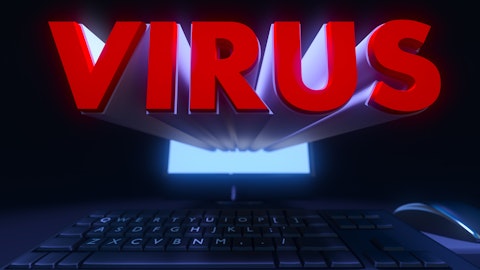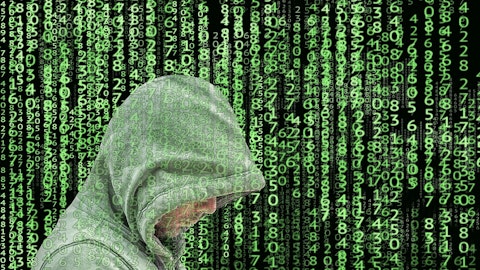Nikesh Arora: So thank you, Gabriela. Look, the firewall business is actually is a one-shot business. You sell a piece of hardware and you get paid for it. It is not a ratable business, right? The ratability comes from our subscription and services part. It’s usually there we have to look at it from an NGL perspective. Our duration this quarter was on the lower-end of duration. It reduced, went down, because we took more annual billing deals or we took shorter-duration contracts with our customers. So from that perspective, I think we feel comfortable given the visibility to our pipeline for the rest of the year that we have flexibility for ourselves on billing. You know, I think we’re going to keep having this debate, where you keep calling it guiding down on billings, I’m going to keep calling it flexibility, you want to keep calling it guideline downward billing, so I’ll keep telling it doesn’t change my numbers.
So we just agree that we’re going to be saying that because I don’t – nothing has changed the prospects of Palo Alto of three months ago.
Gabriela Borges: Thank you.
Walter Pritchard: All right. Thanks for your question, Gabriela.
Dipak Golechha: May just to build on that, Walter, I’d say like just recognize that we’re also maintaining our cash guidance, which would be the other area where we may get concerned, we’re not concerned on that front.
Walter Pritchard: Great, thanks, Gabriela there. Next question is from Roger Boyd at UBS, followed by Brad Zelnick at Deutsche Bank. Go ahead, Roger.
Roger Boyd: Great, thanks for taking the question. Just looking at the XSIAM pipeline, that $1 billion dollars is a pretty impressive mark, just any color you can provide on the size of the length of those deals as we think about it from an ARR perspective? I know you’ve talked about the 3x ARR upsell or expansion potential, but just any color on the size of those deals and how we should think about that kind of flowing into opportunities over the course of fiscal ’24.
Nikesh Arora: Yes, I’m trying to make sure Lee gets to ask some questions otherwise he doesn’t want to show up next time. Yes, exactly.
Lee Klarich: Yes, look, we’ve obviously, over the last few quarters we have been talking about XSIAM, and the interest we’re seeing from customers is very strong and it’s been the fastest sort of growth of a new product that we’ve ever seen. I think it speaks to a couple of things. One is just the need in the market from customers to go through the SOC transformation. Nikesh, talked about the speed of attacks, increasing relative to disclosure requirements and things like that, and obviously the number of attacks going up as well. That’s driving the technology needed to have a different solution, a better solution, one driven by AI and automation. That’s exactly how XSIAM was built. And that is what was feeling the interest.
The second part of this is, with XSIAM, we’re able to replace several of the customer’s legacy point solutions in the SOC. So we are consolidating multiple independent piece parts with a single XSIAM deployment. And third, with these deployments of XSIAM, this is a significant investment the customer is making in us [technical difficulty] investments are three-year investments and in some cases even longer because they’re standardizing their stock on a new platform. They want that long-term runway with us. This is not a short-term decision they’re making. So all of those factors are what are fueling the strong pipeline that we shared in the early customer success we’re having with the saying.
Walter Pritchard: Great, thank you for the question. Next question from Brad Zelnick at Deutsche Bank, followed by Fatima Boolani of Citi. Go ahead, Brad.
Brad Zelnick: Great, thanks very much for taking the question. I wanted to ask about your new hardware lineup and the release of PANOS 11.1. I noticed some of the newer features like quantum security and advanced wildfire patient zero prevention. I just wanted to get your take on the extent to which the new platform can catalyze demand as customers try to look to take advantage of the innovation and maybe if you could, you know, help us compare contrast versus prior product cycles. Thanks.
Nikesh Arora: Yes, thank you. I always get excited about the Next-Gen firewall releases of course. Look, what we announced was a new high-end chassis, so one that scales beyond a terabit per second. And so there is, obviously, this is the largest highest performance networks out there, service provider and in some cases large enterprise environments, at the same ruggedized platforms, platforms that can go to plus 50 degree Celsius, minus 40 degrees Celsius, because there are harsh environments out there that also need to be protected, right? So, this is expanding the use cases that we can support with our hardware next-gen firewalls. The other pieces you mentioned are also equally exciting from a software perspective. You know, Quantum is still likely a ways off, but there’s a lot of companies that are starting to prepare for that, thinking about what happens in post-Quantum cryptography in the advent of potential computers and what that will mean, and so this is the start of a set of Quantum security capabilities that we’re launching for our customers.
You mentioned, advanced WildFire, we added proxy capabilities. We added ADEM capabilities, so there’s a lot of innovation that’s in this release. Generally in what this drives is customers to look to be on our latest Gen IV or newer hardware architectures, which over time means hardware refreshes and upgrades. And so all of that is good and helps our customers get to the most secure state.
Brad Zelnick: Well, thank you.
Walter Pritchard: Great, thank you for that. Next question is Fatima Boolani at Citibank, followed by Joel Fishbein from Truist Securities. Go ahead, Fatima.





